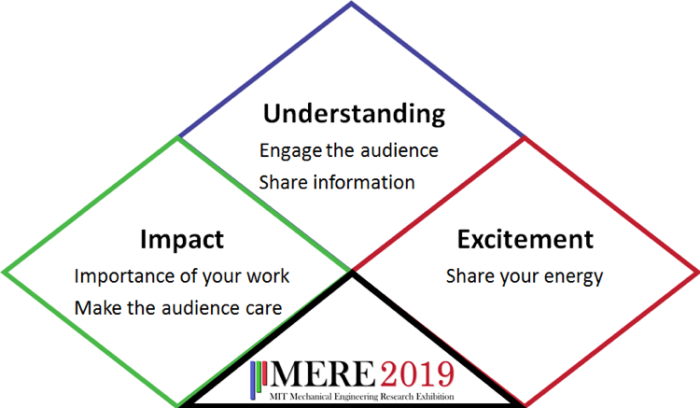MIT’s Mechanical Engineering Research Exhibition (MERE) is one of the first big events in the department each fall. As one of the organizers of MERE 2019, I had a birds eye view of the poster presentation, the audience, the judging, and our goals. Whether you’re looking to present at MERE or another poster exhibition, perhaps this description can help you to level up your poster and presentation.
MIT’s MechE Department has over 400 graduate students in over 100 different research labs. With everyone focused on their own research, it can be hard to get to know what everyone else is doing! One of our core aims for MERE was to introduce MechE students to the huge variety of research in the department. Another core aim was to give everyone a low-risk chance to practice presenting to people outside their own lab groups. We were able to host over 60 graduate students and a few undergraduate students presenting their research, many for the first time.
The way we run MERE is to fill a room with posters and presenters for a day, and make it a competition to engage the audience and tell the best story, with food, cash prizes, and an invited speaker to turn the event into a day to enjoy. Whether you’re aiming for first place, learning how to talk about your research in a way that makes sense, or wandering through to learn about research in MechE, there is something for you.
Tips for giving your best presentation:
- Practice! Even if you make the best poster in the world, it can’t speak for itself. You should be prepared to give a 20 second overview of your research that anyone who visits the poster can understand. At MERE, you can assume they will have a technical background, but they probably don’t know the details of your specific field.
- Show the impact of your research. The best presenters I saw were able to explain why they were doing the research they were doing, and they did this by explaining the context of their research and what they were doing differently.
- Speak to your audience. Since the audience was made of industry professionals, other students, alumni, and faculty, poster presenters had to be flexible to present their research in a way that would interest whatever people were interested in their posters. If you’re unsure about the background of the person visiting your poster, a good way to start is to ask: “How familiar are you with microfluidics [or your topic]?” and go from there.
- Have demonstrations. Hearing about the device you built is pretty cool – but being able to see it move? Amazing. Not every research project has a physical output, but even a good image or video kicks the presentation up a notch.
- Go see other posters. A main point of our competition is to see what else is going on – so don’t stand at your own poster the whole time. Go find other research projects that interest you – and maybe learn something from the presentation styles other people use.
See the MechE CommKit for more details on poster design.

MERE goals (and judging criteria) for the poster presentation: share what your research is about, why it matters, and get them excited about what you’re doing!
Blog post by Crystal Owens
